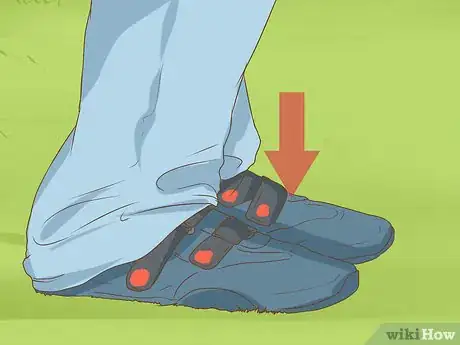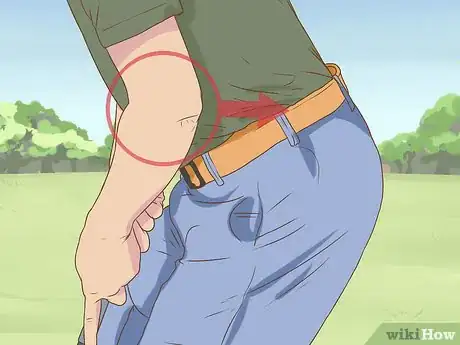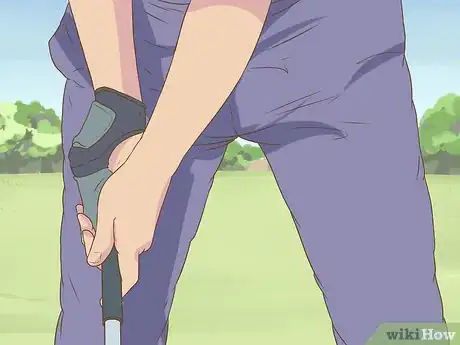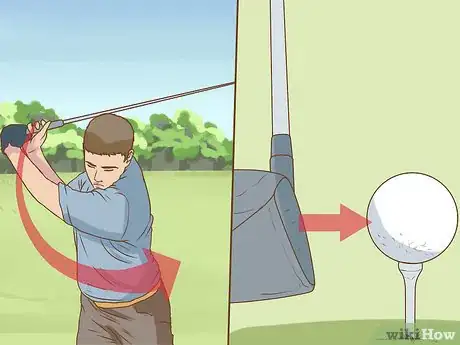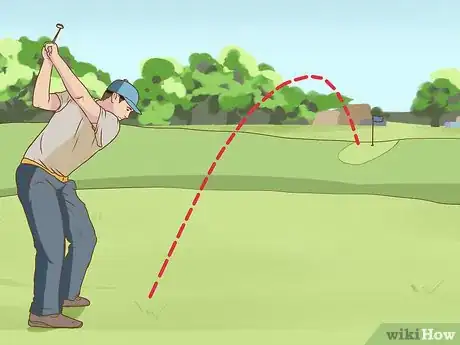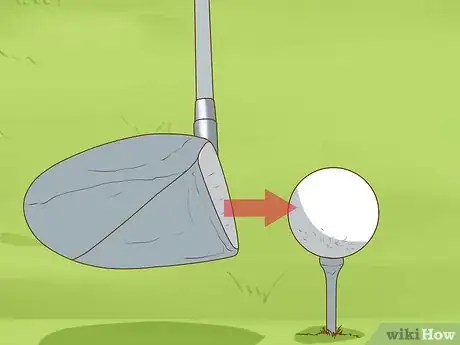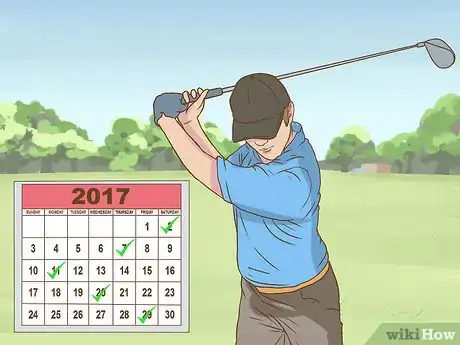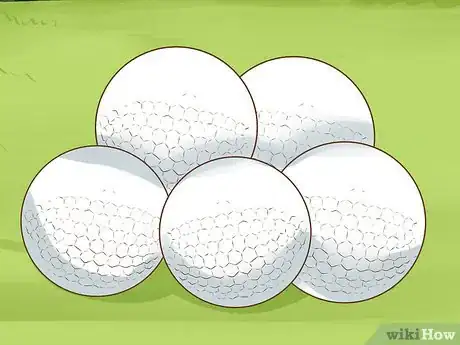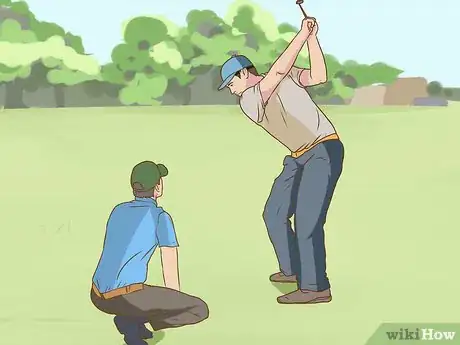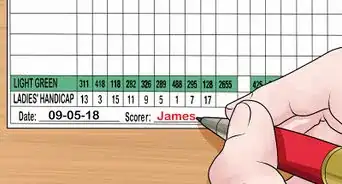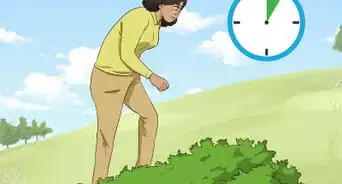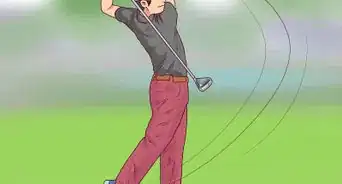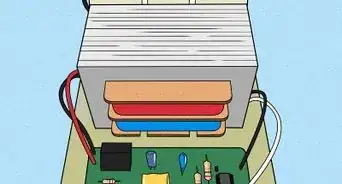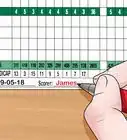This article was co-authored by Michael Metz. Michael Metz is a Golf Instructor and the Director of Instruction at Simi Hills Golf Course. With more than 15 years of experience, Michael is adept at coaching all facets of Golf. Mike uses technology, such as Flightscope, V1 Swing Suite, Blast Motion, and BodiTrak pressure mapping, to provide advanced golf training with quick results.
There are 14 references cited in this article, which can be found at the bottom of the page.
This article has been viewed 143,518 times.
Whether you’re a professional or a beginner, anyone can enjoy a game of golf. Golf is a great way to relieve stress and stay athletic. No matter experienced you are, it is great to make efforts to get better at golf. To improve your game, improve your form, learn golfing techniques, and keep some strategies in mind.
Steps
Improving Your Form
-
1Anchor your foot. One of the most basic tips to get greater distance is to anchor (firmly press into the ground) your foot and your body behind the ball. The foot you must anchor is the foot that is behind the ball. For right handed players it will be the right foot, and the left foot for left handed players. If you lift your foot too soon when swinging the club you will lose power and distance in the shot.[1]
-
2Touch your elbow to your hip. If you can’t touch your elbow to your hip, at least keep your arm close to your hip. By keeping the right arm close to the hip, you ensure the body will drive your arms and club through the ball impact. This will decrease the chances of your hands negatively influencing the shot.[2]
- Keep your left arm close to your hip if you’re left-handed.
- Position your hands and club so that they’re about a fist-width away from your body.
Advertisement -
3Relax your muscles. Relax and keep your grip light. At the top of your backswing, make a slight pause and maintain a light grip through the swing. To keep a light grip, relax the muscles in your forearms and also your fingers. If you do this, you will create a faster, brisker swing release through the ball impact. This will result in a longer drive.[3]
- Take deep, even breaths to help relax.
-
4Rotate your hips vigorously. By energetically rotating you hips on the downswing you will bring your core muscles into play. This will increase club head speed, and therefore will result in a longer drive. Make sure you do this in a controlled manner. Keep your foot anchored to prevent slicing the ball.[4]
- Slicing the ball is when the golf ball curves dramatically from the left to the ball after a shot.
-
5Use a short controlled backswing. Do this to achieve a longer drive. A common failure amongst golfers is bringing the driver too far back during the backswing. This causes a loss in control of the club. A powerful, more controlled swing can achieved by controlling your wrists and rotating your body into the shot, thus resulting in a more distance.
- Your hands should be level with your shoulders when you bring the club back.
Learning Golfing Techniques
-
1Let the club do the work. A common misconception amongst golfers is that the harder they whack the ball, the further it will go. You should actually focus on the middle of the ball and the control you have over your swing. This will give you far better results than trying to increase the power of your swing. Hitting the ball too hard will invariably mean a slice or a fresh air shot.[5]
-
2Don’t rush the shot. Slow down and focus on your balance. The speed you hit the ball doesn’t initially matter, especially when you’re learning to improve your swing. Instead of rushing through the shot, find your balance and slow your swing. Once you’ve mastered your swing, you can gradually increase the power and speed you use when driving the ball.[6]
- Instead of muscling the shot, use your left hand to control the club during the swing. Use your right hand if you’re left-handed.
-
3Visualize the shot. When taking your practice swings, imagine the shot you wish to hit. Picture the ball’s flight when you make your practice swing. Make sure your swing feels comfortable. This technique will relax your body as well as your mind. Also, never take too many practice swings, as the thought of fluffing the shot will build up in your mind and affect your confidence.[7]
-
4Reduce spinning by teeing the ball higher. Hit the drives with minimal spin on the ball. To achieve this, you can tee the ball up high. This will promote less spin on the ball as you will be hitting it from a more underneath position. Also, try to avoid moving forward over the ball on impact. This will always reduce spin.[8]
-
5Practice as often as possible. Consistency in the amount of times you get out there and play is crucial to a good game. To hone your golfing skills, you must play regularly. You will not improve if you don’t practice. You will learn to tweak your game a little bit more each time you play, and bring the lessons you learned the previous week to the course with you the following week.[9]
Keeping Extra Strategies in Mind
-
1Choose a good set of clubs. Even for professionals, the type of clubs used matters. The type of clubs you choose depends on if you’re at a beginner, intermediate, or advanced level. A set of three woods and eight irons is sufficient if you’re a beginner. Most club sets will work for a beginner. Make sure the clubs fit your strength and posture. Once you reach the intermediate level, a good set of clubs are ones that have been fitted for you.[10]
- Sometimes bigger clubs are better because it means greater inertia.
- Go to a sports or golf store to get fitted for clubs. This way, your clubs will be the correct size for you and your needs.
-
2Choose a good ball. You can use any type of ball, but some balls are better than others. You want a ball that will go the farthest distance. Yardage is more important than spin. Look for a ball that is not too light or heavy.[11]
- Ask for the advice of an employee at your local sports equipment store if you’re not sure which golf balls to choose.
- It’s not necessary to go for the most expensive option if you’re just playing for fun.[12]
-
3Take lessons. Taking golf lessons is a sure way to improve your game. They are especially helpful for beginners. Golf lessons can help you learn etiquette, improve technique, learn technical aspects, and familiarize yourself with your equipment. This, however may not work for everyone because lessons can be costly.[13]
- You can sign up for golf lessons at country clubs, gold academies, and from private instructors.
-
4Keep fit. As with any game, you need a certain level of fitness to maintain the ability to play well. To keep fit, you can stretch, go to the gym, and/or enjoy any other physical activity. Stretch your hamstrings, quads, arms, and back before playing. Try to go to the gym at least twice a week. For physical activities, you can run, do yoga, or play other sports.[14]
- Only do as much physical activity outside of golfing as you are comfortable with. Don’t put too much strain on your body.
Community Q&A
-
QuestionHow do I stop moving my feet when taking my swing?
 Community AnswerMake sure you have your feet planted. Most of your weight should be on your back foot (dominant foot) and then transfer into your front foot (non-dominant foot) as you come through with your swing.
Community AnswerMake sure you have your feet planted. Most of your weight should be on your back foot (dominant foot) and then transfer into your front foot (non-dominant foot) as you come through with your swing. -
QuestionI can't get off the tee or hit the 1st shot after the tee shot. What should I do?
 Community AnswerIt sounds like the problem is your swing. Take some time practicing your swings and focus on where you're hitting the club to the ball.
Community AnswerIt sounds like the problem is your swing. Take some time practicing your swings and focus on where you're hitting the club to the ball. -
QuestionWhy is golf so difficult?
 Community AnswerLike any sport, it takes time and effort to make the game easier. Golf is hard for everyone at first.
Community AnswerLike any sport, it takes time and effort to make the game easier. Golf is hard for everyone at first.
Warnings
- Playing golf can be expensive. Don’t feel like you have to spend a lot of money to improve your game.⧼thumbs_response⧽
- It is good to practice, but don’t practice so much that you exhaust yourself. Tiredness leads to injury.⧼thumbs_response⧽
References
- ↑ http://www.golftipsmag.com/instruction/quick-tips/anchor-your-right-foot/
- ↑ http://www.golf.com/instruction/johnny-miller-7-ways-play-round-your-life
- ↑ http://www.golf.com/video/how-relax-your-muscles-golf
- ↑ http://www.golfdigest.com/story/sean-foley-make-me-better
- ↑ http://www.beaufort.com/swinging-the-club-not-hitting-the-ball/
- ↑ http://www.golfdigest.com/story/tom-watson-driver
- ↑ https://golfstateofmind.com/powerful-visualization-golf/
- ↑ http://www.golfdigest.com/story/rulesprice
- ↑ http://www.golf.com/instruction/deliberate-practice-key-improving-your-golf-game
- ↑ http://www.franklygolf.com/simple-rules-for-buying-golf-equipment.aspx
- ↑ https://www.linksmagazine.com/10_tips_for_buying_golf_clubs/
- ↑ http://www.franklygolf.com/simple-rules-for-buying-golf-equipment.aspx
- ↑ http://longestshotclub.com/5-benefits-golf-lessons-beginners/
- ↑ http://www.mensjournal.com/health-fitness/exercise/6-steps-to-getting-golf-fit-20140807
- ↑ http://www.golftipsmag.com/instruction/shotmaking/8-tricks-to-become-a-better-player/
About This Article
To improve your golf game, warm up by taking a practice swing so you can focus on anchoring your back foot and keeping your muscles relaxed. While practicing, visualize the type of shot you want to hit and where you want the ball to go. When you swing, aim for a short backswing by only swinging until your hands are level with your shoulders so you can keep control of the club. As you hit the ball, try to hit the center of the ball and let the club do the work, rather than whacking it as hard as you can. For tips on what clubs to choose and how to take golf lessons, read on!
